Now let's look briefly at what are tomato disease photo and their treatment from which leaves are twisted.
1. There is a curl of the sheets most often when the normal temperature regime is not observed. As you know, at high temperatures, the decomposition of nutrients faster than assimilation. This starvation leads to the fact that the plants become ill. This is especially noticeable when tomatoes are grown in greenhouses. The roots are in cold earth, and the top of the plant is exposed to high temperature conditions. For this reason, in hot weather, it is necessary to ventilate the greenhouse.
2. Twisting the leaves down indicates that the plant is affected by bacterial cancer. The leaves that are below with time become brown and dry, and noticeable sores and cracks appear on the stem. If you cut the stem affected by bacteriosis, then a brown ring will be visible inside.
3. The reason for the curling of the leaves is also due to phosphorus starvation. A sign of such a disease is a discoloration of the upper part of the plant. It turns gray-green, and the veins on the leaves are purple.
4. Folding leaves on tomatoes that are already bearing fruit indicates an excess of zinc. Such a problem on the leaves of a young plant indicates a lack of boron, copper, and sulfur. Curled up, it means that there is not enough potassium seedlings. In this case, the leaves become small, the growth points die off, and the fruits begin to rot.
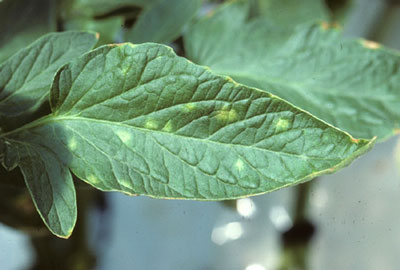
Methods of struggle with folk remedies
If you do not want during growing tomatoes treat them with chemicals, then you can use simple and inexpensive folk remedies that will help to prevent or cope with some diseases.
- Spraying with garlic infusion. Mushroom spores die from it. Preparing the infusion is not difficult. In a bucket of water you need to chop one and a half glasses of chopped garlic along with the shoots. Insist this mixture for a day, then add 2 g of potassium permanganate. Spray twice. The first time before the appearance of the ovary, then every 10 days.
- Spraying with iodine milk. This method has proven itself, as many people know the antimicrobial properties of iodine. On the leaves of a tomato, he will be able to restore order, and fruit ripening will accelerate. You need 1 liter of milk per bucket of water and add 20 drops of iodine.
- Spraying with ash. This treatment should be carried out three times a season. The first time seedlings take root, the second time before the tomatoes bloom and the third after the appearance of the first ovary. On a bucket of water you need to prepare half a bucket of wood ash. Let it be insisted for three days, but it must be periodically mixed. Then let the prepared solution settle and dilute it to 30 liters, grate 30 grams of laundry soap and add to the preparation.
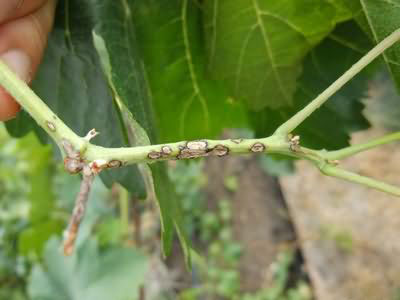
Blight treatment
Phytophthora does not spread much until mid-summer, but you do not need to relax. A rare case when this insidious disease passes by and does not hit the plant. Many people know about such a disease of tomato photos and their treatment of late blight - these are fungal spores that annually destroy most of the crop. The more she comes, the more drugs appear against her.
Treatment is difficult when disease prevention is not completed on time. What can be done to save the crop? Tomatoes must be planted on those plots of land where potatoes, as well as tomatoes, have not been grown for several years in a row. The remains of vegetation must be burned without fail. Find out, which varieties of tomatoes are better for growing in greenhouses.
The most powerful method of controlling late blight is the treatment of plants with a Bordeaux mixture. It is important to observe the correct proportions so as not to cause burns on the plant and existing fruits. Treatment should be carried out every 10 days, until the symptoms of the disease disappear. You can use copper chloride, and other modern methods.
The main diseases of tomatoes
Tomato leaves themselves have insecticidal properties, even their decoction is used to remove pests. But still there are diseases of tomato photos and their treatment is simply necessary in order to have a crop.
Gray and white rot. It is caused by many pathogens and appears at the moment when the fruits for ripening are removed. Infected tomatoes disappear very quickly.
White spotting is expressed in the coating of the stems with small spots that are gray-white in color, and the edges of the leaves are dark. Later, small dots appear. Infected leaves die off quickly and subsequently dry. The disease begins to progress from the leaves that are below. And gradually rises up. Crop is significantly reduced.
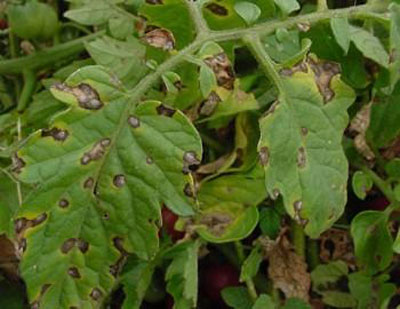
This tomato disease can be defeated with the help of chemicals: 0.5% copper chloroxide or 1% Bordeaux mixture.
Black spotting is an infectious disease that affects the petioles and leaves of tomatoes, and the stems of the plant become weak over time.
At this time, the plants stop growing and, if you do not fight the disease, the plant disappears.
Fighting tomato diseases in a greenhouse
Stem rot or in another name is called the “black leg” - these are diseases of tomato photos and their treatment, in the greenhouse it develops rapidly. After the first signs, action must be taken immediately. After all, the disease can completely destroy the lower part of the stem. The affected stem becomes thin, in addition, the plant then poorly takes root. Tomato disease spreads if the greenhouse has high humidity and not only on the surface of the earth, but also in the air.
To protect tomato seedlings from this disease, you first need to disinfect the soil, and then pickle the acquired seeds. It is important to ensure that crops are not thickened. Water them moderately, and often ventilate the greenhouse.
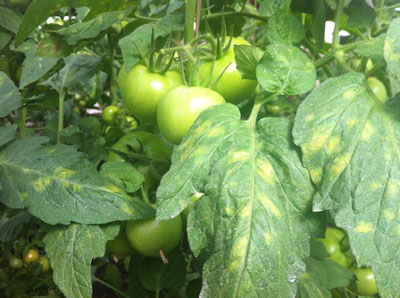
Streakiness is a viral disease. It affects the plant completely. The disease manifests itself in the fact that brown-red stripes appear on the stem and petioles. The source of the virus is the seeds themselves, if they are collected from a sick fetus.
What control measures exist? It is important to collect seeds, not from infected fruits, but immediately before sowing, be sure to pickle them with a potassium permanganate solution. Follow all the rules for growing seedlings in a greenhouse. As soon as the first symptoms appear, immediately remove the infected plants.
Other tomato diseases
There are many diseases from which tomatoes suffer, and to a greater extent they are infectious. Such tomato diseases photos and their treatment video plot will show how they are able to spread and what happens after that.
Vertex rot is an infectious disease. It develops under the influence of strong evaporation of moisture. This happens when the weather is hot and dry, and there is not enough moisture in the soil. Then on top of the fruit itself appear hard, dry spots that have a brown color. They penetrate deep into the entire pulp of the tomato. The main method of controlling top rot is regular and regular irrigation, as well as sufficient oxygen saturation of the soil.
Dry spotting (macrosporiosis) is a disease that causes the death of leaves. Dark spots and a black coating also appear at the base of the fetus. Measures against dry spotting are the same as with late blight. Find out, how to grow tomatoes according to the method of Maslov.
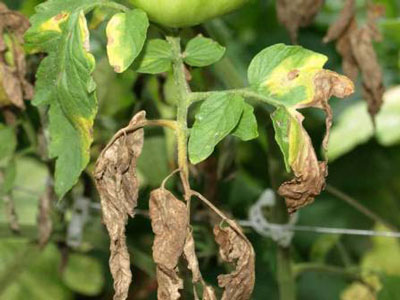
Fruit cracking is not an infectious disease. The cause of this damage may be excess moisture in a drought. In this case, the tissue simply ruptures in the walls of the fetus.
Mosaic is a disease that is caused by a certain type of virus. It leads to loss of yield, and to the death of the plant itself. Such a disease manifests itself in a change in the color and shape of the leaves. They begin to turn yellow, then frown, curl and dry.
To prevent this from happening, the seeds must be pickled with a potassium permanganate solution, and then produced by watering the same liquid several times a day.
Tomato Seedling Disease
There are also diseases of tomato seedlings photo and their treatment is very important. In addition to the above diseases, there are also not very common ones. They are closely related to the imbalance of plant nutrition and the crop suffers from them. This is a lack of nutrients, and an imbalance in minerals. The reason may be a deficit in the soil of useful elements, a gross violation of planting seedlings, soil features that do not allow the splitting of some elements.
It is important to pay attention to how fertilizers are used. It must be remembered that tomatoes are better fed with mixtures that do not contain chlorine. But its complete exclusion can lead to the fact that water exchange will be disrupted. From this the leaves will sag. To avoid this, you need to add a small amount of edible salt when watering the seedlings.
Recommended: How to feed tomato seedlings after a dive
A common tomato disease is root rot. The cause of the disease is mushrooms. This disease is expressed in the wilting of the plant, since the basal neck begins to rot. You can correct the situation if you water the soil with the addition of a solution of copper sulfate, as well as treatment with drugs such as Barrier or Barrier.
As can be seen from this article, all diseases can be defeated, the main thing is to know the correct methods of dealing with them and to carry out prevention on time.

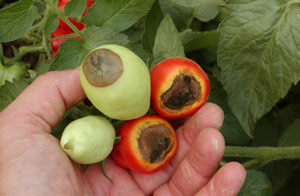



 Low-growing tomatoes, without pinching: 5 of the most delicious varieties
Low-growing tomatoes, without pinching: 5 of the most delicious varieties Why tomato seedlings grow poorly
Why tomato seedlings grow poorly We grow a tomato in a shell
We grow a tomato in a shell Growing tomatoes without watering according to the method of Kazarin
Growing tomatoes without watering according to the method of Kazarin